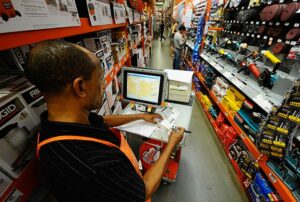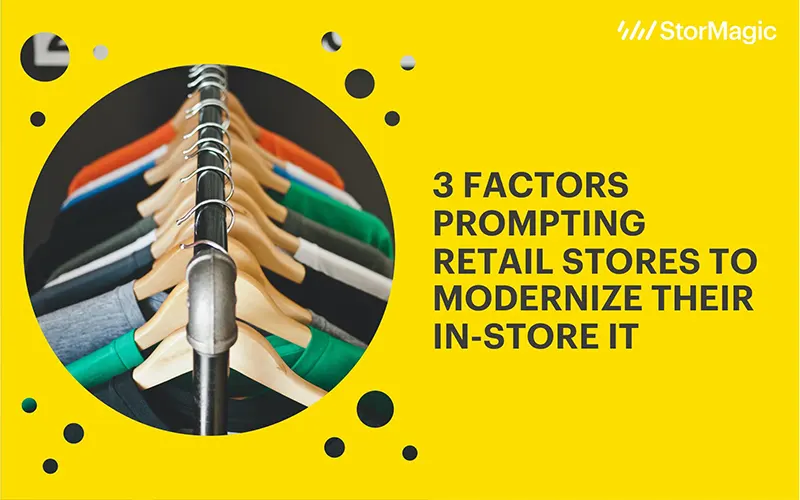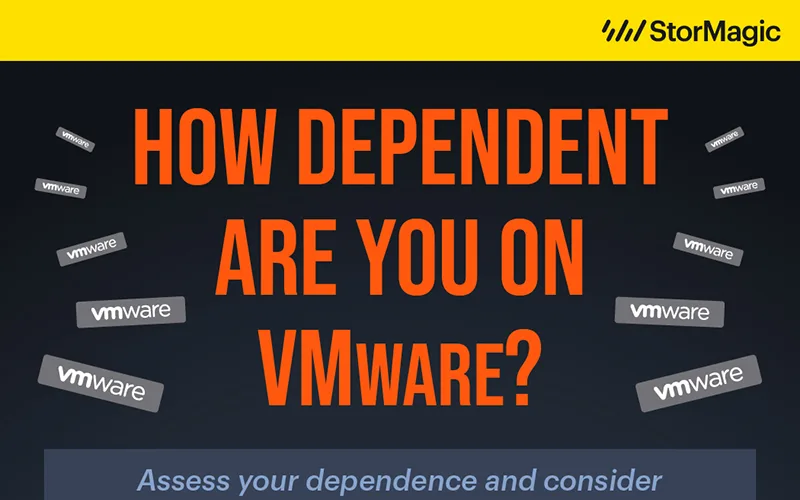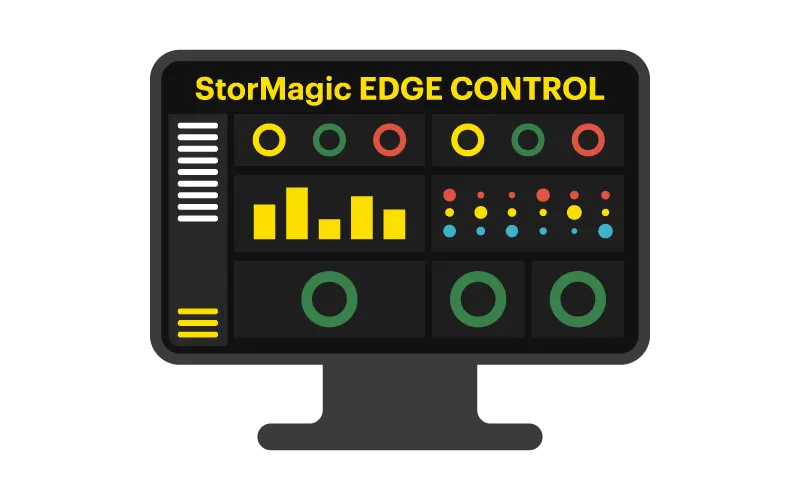For modern retailers, managing a growing brand is no simple task. While their main goals may be to produce quality products, provide excellent customer service, and work towards growing profits, several other key factors are coming into play as technology advances. Maintaining an online presence through things like social media, virtual shopping, and digital advertising is now just as defining to a brand’s success as operating physical retail stores. In addition, more and more brick-and-mortar-style stores are popping up around the world as digital brands work towards establishing a physical presence.
Keeping track of these countless moving parts is incredibly challenging… So, why should retail stores also have to deal with the headache of handling complicated, unreliable, on-site data storage?
They shouldn’t!
Today, the three main factors prompting retailers who are keen on staying a cut above the competition to modernize in-store IT infrastructure include:
1. The need to reduce downtime with a reliable, highly available system
 Today’s retail organizations are managing more digital applications than ever before. As a result, they have a lot at stake when it comes to IT downtime, including loss of revenue, customer loyalty, brand equity, and employee productivity. Ensuring in-store applications (i.e. POS software, video surveillance, stock control, digital signage) are highly available is a number one priority.
Today’s retail organizations are managing more digital applications than ever before. As a result, they have a lot at stake when it comes to IT downtime, including loss of revenue, customer loyalty, brand equity, and employee productivity. Ensuring in-store applications (i.e. POS software, video surveillance, stock control, digital signage) are highly available is a number one priority.
In the event of hardware failure or maintenance, each store should have a reliable IT system in place, with adequate redundancy at every point. This includes power supplies, networking equipment, and servers themselves. A shared storage environment enables identical copies of data to be held simultaneously on multiple servers, thereby creating a highly available environment. Best practices on creating a highly available configuration can be found in this white paper.
2. The need for lightweight, low-cost IT solutions
![]() Managing complex, clunky IT hardware onsite at a retail store is less than ideal. It’s also expensive for business owners looking to deploy the same infrastructure across hundreds or even thousands of stores. Space restrictions within physical retail locations are increasing as online shopping giants take over, and every inch of store space not used for selling contributes to loss of revenue.
Managing complex, clunky IT hardware onsite at a retail store is less than ideal. It’s also expensive for business owners looking to deploy the same infrastructure across hundreds or even thousands of stores. Space restrictions within physical retail locations are increasing as online shopping giants take over, and every inch of store space not used for selling contributes to loss of revenue.
With virtualized storage, the amount of physical hardware required at each location is reduced significantly. Retailers are able to run many applications using only two physical servers, reducing resource consumption and slashing hardware costs. Virtualization technologies are not only considerably less expensive to buy, install, and operate, but also make unused space available for other resources. Furthermore, through centralized management, in-store IT systems at each location can be managed remotely, decreasing labor and infrastructure costs.
There is of course another option – the cloud. But that’s not necessarily the right answer for retail organizations looking to keep data storage and processing local, as well as keeping a handle on costs. The pros and cons of both cloud and local storage are dealt with in this blog.
3. The need for flexibility and scalability to support business growth
![]() As retail brands grow, business owners seek to expand their reach, opening additional store locations across their state, then country, and eventually around the world. In-store IT demands vary greatly between different retail organizations, and sometimes even within a single business (between stores).
As retail brands grow, business owners seek to expand their reach, opening additional store locations across their state, then country, and eventually around the world. In-store IT demands vary greatly between different retail organizations, and sometimes even within a single business (between stores).
Accommodating variations in requirements, and having the capability to quickly and cost-effectively scale and replicate, requires a flexible IT solution that doesn’t lock the retailer into specific configurations or hardware specifications. Organizations have the option to deploy the bare minimum storage capacity and computing power needed to support the applications for a specific store, and then scale up over time as needed. Check out our own advice on scaling IT infrastructure up and out for future requirements.
Modernizing Retail In-Store IT with StorMagic SvSAN
Ensuring high availability in retail stores is crucial, as unplanned downtime can result in a loss of revenue and damage to your brand. However, it can be hard to find a solution that delivers 100% uptime without adding unnecessary complexity and costs. StorMagic SvSAN is the easy way to eliminate downtime at retail stores.
The lightweight software-defined storage creates a simple, highly available 2-node VSAN cluster, using any two x86 servers with any type of data storage.
Storage virtualization provides an easy way to enable hyperconverged infrastructure in small sites, like retail stores, and is the perfect HCI solution for small sites that have limited space and onsite IT staff, and require 100% uptime for mission-critical applications. SvSAN is the most cost-effective hyperconverged storage solution of its kind on the market. It is incredibly easy to deploy, allowing 1,000 sites to be managed as easily as 1.
But how does this look in action?
 A large US-based retail chain has deployed SvSAN in around 3,000 of their stores – that’s a 2-node SvSAN cluster at every location. Their highly available infrastructure requires only four remote witnesses, which are strategically located around the country, providing quorum for all of the clusters, enabling 2-node high availability. Competing software-defined storage solutions would require 3,000 witnesses and a LOT more hardware to run.
A large US-based retail chain has deployed SvSAN in around 3,000 of their stores – that’s a 2-node SvSAN cluster at every location. Their highly available infrastructure requires only four remote witnesses, which are strategically located around the country, providing quorum for all of the clusters, enabling 2-node high availability. Competing software-defined storage solutions would require 3,000 witnesses and a LOT more hardware to run.
 Servers failing due to a bad lot from their vendor could have spelled disaster for US retailer, Sheetz. The company has many convenience stores dotted around the country and some monitoring of their hosts had not been working as intended. Prior to the incident occurring, the company had implemented SvSAN, so a transition from a failed node to the secondary was seamless, and no problems were caused in any of Sheetz stores.
Servers failing due to a bad lot from their vendor could have spelled disaster for US retailer, Sheetz. The company has many convenience stores dotted around the country and some monitoring of their hosts had not been working as intended. Prior to the incident occurring, the company had implemented SvSAN, so a transition from a failed node to the secondary was seamless, and no problems were caused in any of Sheetz stores.
Other benefits experienced by the retailer include a greatly reduced time to return failed physical devices to service, the ability to grow their StorMagic footprint without having to add a commensurate number of witness devices to their infrastructure to manage them, and phenomenal uptime.
For more information about why SvSAN has worked so well for other retailers, check out our case studies page. Alternatively, jump over to our SvSAN for retail page for more resources explaining how SvSAN addresses in-store IT challenges:




